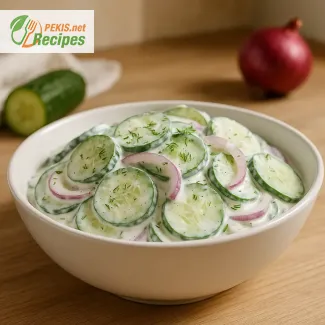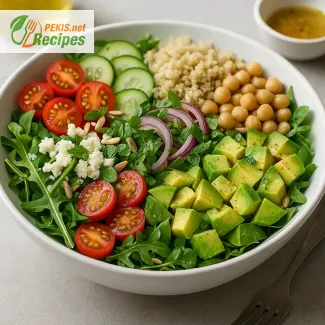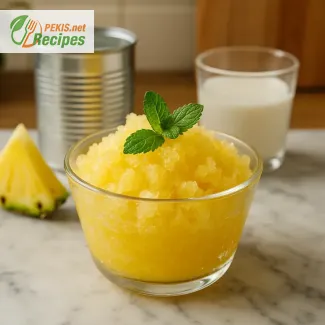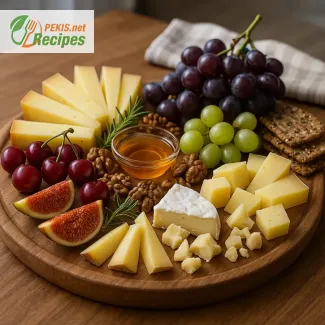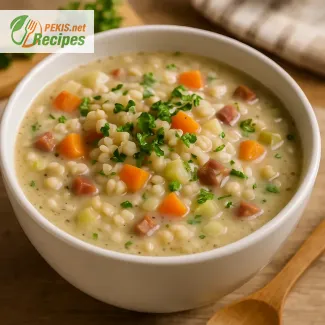
Discover the cooling charm of Swiss barley soup on hot alpine days
A revitalizing traditional soup from the heart of Graubünden
In the alpine regions of Switzerland, where tradition meets nature, cold Swiss barley soup—known locally as Bündner Gerstensuppe—offers a refreshing escape from the summer heat. Unlike heavier soups meant for winter, this unique barley-based dish is designed to cool and nourish, especially after a morning hike or an afternoon under the sun. Originating in the mountainous canton of Graubünden, this rustic barley soup was historically served warm in colder months, but its cold version has steadily gained popularity as a summer staple throughout Swiss households and alpine inns.
What makes this dish truly stand out is its blend of hearty simplicity and regional purity. While the main ingredient, pearl barley, offers a chewy, satisfying texture, it’s the addition of local vegetables, cured meat, and fresh alpine herbs that elevate the soup into something exceptional. Served cold, it becomes not just a traditional dish but a culinary symbol of seasonal adaptation and mountain freshness.
The unique culinary identity of Bündner Gerstensuppe
The Bündner Gerstensuppe is more than just a soup—it's a direct reflection of Swiss culinary heritage. Born in the high-altitude valleys of Graubünden, this dish represents a blend of farmer cuisine and alpine resourcefulness. As refrigeration became more accessible, locals began to serve the leftover barley soup cold, realizing that its flavor deepened and became even more satisfying after resting for a few hours in a cool pantry or cellar.
The cold adaptation retains all the character of the original: smoked bacon or Bündnerfleisch, creamy root vegetables, onion, leek, and freshly chopped parsley. When chilled, the flavors meld in a way that delivers both richness and clarity—a duality that has helped the dish transcend its humble origins and find its place on modern summer menus across Switzerland and beyond.
Why cold barley soup is perfect for summer
Serving cold barley soup in summer offers more than just relief from the heat. Barley is a complex grain rich in fiber, making it a filling yet light base that doesn’t weigh the stomach down. The cool temperature of the dish also supports hydration, especially when prepared with homemade vegetable broth and fresh herbs.
Its versatility is another advantage—this soup can be a starter or a main course, depending on how it’s served. It pairs beautifully with a slice of crusty rye bread or a cold platter of Swiss cheese. For vegetarians, versions without meat still maintain the signature flavor profile through smoked salt or mushroom-based broth, proving how adaptive this classic can be without sacrificing tradition.
Seasonal ingredients that define its taste
A truly authentic cold Swiss barley soup relies on the quality of local, seasonal produce. Root vegetables like carrots, celery root, and leeks add sweetness and depth, while the star—Swiss pearl barley—gives the dish its signature texture. The inclusion of smoked meats like bacon or air-dried beef introduces a subtle umami note that balances the freshness of the vegetables.
For the summer version, many cooks add a few tablespoons of crème fraîche or plain yogurt before chilling, giving the soup a creamy consistency and a delicate tang. Chopped chives or parsley, often added just before serving, boost both color and aroma.
Cultural significance and modern popularity
In recent years, the cold version of Bündner Gerstensuppe has made a comeback in gourmet interpretations of traditional alpine recipes. Featured in Swiss restaurants from Zürich to St. Moritz, this dish has proven that cold soups can hold their own beside gazpacho or vichyssoise when executed with care.
It’s also featured in seasonal cooking classes, local tourism menus, and even packaged for quick consumption in health-focused food markets across Switzerland. Its low-fat content, natural ingredients, and cooling qualities make it especially attractive to younger generations looking for healthy, convenient, and authentic meals.
As a testament to Swiss mountain cuisine, cold barley soup carries the story of generations, fields, and family kitchens. Whether served in a rustic chalet or a modern summer table in Zürich, this soup continues to delight those who discover its unassuming complexity and enduring flavor.
Step 1 – Prepare the base:
Rinse the pearl barley thoroughly under cold water. In a medium pot, bring water to a boil and parboil the barley for 5 minutes. Drain and set aside.
Step 2 – Sauté vegetables and bacon:
In a large soup pot, melt the butter (30 g / 2 tbsp) over medium heat. Add the onion, leek, carrot, celery root, and garlic, and sauté for 5–7 minutes until softened but not browned. Add the smoked bacon and continue cooking for another 3 minutes.
Step 3 – Simmer the soup:
Pour in the vegetable broth or beef stock (1.5 l / 6 ⅓ cups) and add the drained barley. Season with salt and black pepper. Bring to a boil, then reduce the heat to low and let simmer uncovered for 50–60 minutes, or until the barley is tender and the flavors have developed.
Step 4 – Cool the soup:
Once cooked, remove from heat. Let the soup cool to room temperature. Transfer to the refrigerator and chill for at least 2 hours (or overnight) to serve it cold.
Step 5 – Finish and garnish:
Before serving, stir in the crème fraîche or plain yogurt (100 ml / ⅓ cup + 1 tbsp). Adjust seasoning if necessary. Garnish each bowl with chopped parsley.
Elevating the Cold Swiss Barley Soup with Modern Touches
Creative adaptations and culinary insights for a richer alpine experience
The humble charm of cold Swiss barley soup lies in its simplicity and rooted tradition. Yet, for today’s cook, there are countless ways to refine and personalize this dish without compromising its identity. Whether you're looking to enhance its flavor profile, adjust it for health-conscious diets, or simply avoid the most common pitfalls in preparation, there are practical and creative strategies that can transform this classic into a standout summer soup.
How changing ingredients transforms texture and taste
One of the easiest ways to elevate this barley soup is by choosing premium-quality ingredients or making subtle substitutions. Traditional versions include smoked bacon or air-dried beef such as Bündnerfleisch, which provide a deeply savory base. However, you can take it further by incorporating pancetta for a slightly sweeter finish or smoked turkey for a leaner alternative. The result is a more complex umami depth, without overwhelming the other ingredients.
For a vegetarian version, smoked paprika combined with sautéed shiitake mushrooms can mimic the depth of smoked meats. Their earthy, aromatic quality gives the broth a rich dimension, and when cooled, they still maintain structure and flavor integrity. Adding a spoonful of white miso paste to the broth before chilling introduces a fermented note that layers beautifully with barley and vegetables.
Boosting the broth with homemade finesse
The heart of any good soup is its broth. While using store-bought stock is convenient, making your own vegetable or beef broth from scratch creates a superior base with cleaner, deeper flavor. Roasting the vegetables—especially the onions, carrots, and celery root—before simmering helps develop sweetness and complexity.
Adding a parmesan rind during cooking (and removing it before serving) can enrich the broth without needing extra salt or fat. Similarly, introducing a bouquet garni made of bay leaf, thyme, and parsley stems elevates the aromatics and infuses the barley with herbal notes that blossom even more after the soup is chilled.
Enriching mouthfeel with dairy and non-dairy options
Though the classic recipe includes crème fraîche or yogurt, other additions can refine both flavor and texture. Greek yogurt offers a higher protein and slightly tangier note, making the soup feel more luxurious and balanced. If you prefer a plant-based option, cashew cream blends beautifully into the broth and creates a velvety texture while keeping the soup lactose-free.
To add body without dairy, puree a portion of the cooked vegetables and barley and stir it back into the soup. This technique creates a natural thickness that still preserves the traditional integrity of the dish.
Choosing the right barley and how to prepare it properly
Barley is the core component, but the type of barley you choose matters. Pearl barley is commonly used due to its quick cooking time, but hulled barley retains more of its outer layer and nutrients, offering a slightly nuttier flavor and chewier texture. Soaking hulled barley overnight can reduce cooking time and ensure it cooks evenly.
To avoid a mushy consistency, never overcook the barley. Stop the cooking when the grains are tender yet firm to the bite. If the soup will be served the next day, it’s best to slightly undercook the barley so it doesn’t break down further as it absorbs more liquid while chilling.
Avoiding common mistakes when preparing cold barley soup
Many cooks make the mistake of over-seasoning while the soup is hot, forgetting that flavors intensify as the soup chills. Season moderately during cooking, and adjust seasoning only after the soup has cooled.
Another frequent error is not cooling the soup quickly enough, which can dull the flavors and affect the texture. Once cooked, the soup should be transferred into a shallow container to cool faster before refrigeration. Stirring in dairy while the soup is still warm is also discouraged—it can lead to curdling or separation, especially with yogurt-based enrichments.
Seasonal vegetable upgrades and freshness matters
While carrots, celery root, and leeks are the traditional vegetables used, the cold version of this soup offers flexibility for seasonal produce. During peak summer, additions like zucchini, peas, or green beans bring color, freshness, and gentle sweetness.
Adding a handful of baby spinach or chopped kale before chilling not only boosts the nutritional value but also introduces a delicate bitterness that contrasts beautifully with the creamy barley and broth.
Freshness is critical, especially in cold soups. Use new-season vegetables whenever possible, and avoid pre-cut or aged produce that lacks flavor intensity.
Healthier alternatives for modern preferences
For a lighter version, replace smoked bacon with lean prosciutto or grilled tofu. Use low-sodium vegetable stock and add salt gradually. Choosing unsweetened plant-based yogurt can reduce fat content and cater to lactose intolerance or vegan diets.
Swapping out part of the barley with quinoa or farro gives the soup an interesting twist while adding protein and texture. However, maintain a good balance to preserve the recognizable identity of the recipe.
Using ghee instead of butter can improve digestibility for those sensitive to dairy solids, and it brings a nutty richness without overpowering the vegetables.
Serving and plating improvements that make a difference
To truly impress, think beyond the bowl. Serve the soup in chilled ceramic dishes to maintain temperature longer. Garnish with microgreens, a drizzle of herb oil, or a dollop of lemon-infused crème fraîche just before serving.
If preparing for a crowd, consider pre-portioning in glasses or small jars, layering barley and vegetables on the bottom and pouring broth over them. This presentation enhances visual appeal and emphasizes the textures.
A wedge of crusty sourdough or a slice of dense rye bread completes the serving, enhancing the rustic alpine character of the dish.
Why homemade versions are always superior
Homemade cold barley soup allows you to control every aspect—from the type of fat used to the quality of stock and vegetables. Unlike commercial options that rely on preservatives, flavor enhancers, or excessive sodium, the homemade version is cleaner, fresher, and more nutritious.
Moreover, preparing this dish at home offers a deep connection to its cultural roots. You are not just cooking but participating in a ritual passed down through generations, transforming local ingredients into nourishment and comfort.
When you take the time to make it yourself, every spoonful tells a story of tradition, health, and creativity—all chilled to perfection.
Allergens present in the recipe:
- Dairy: Present (butter, crème fraîche/yogurt)
- Gluten: Present (barley)
- Possible traces of celery (in stock)
Allergen-free substitution tips:
- For dairy-free: Replace butter with olive oil and crème fraîche with unsweetened soy or oat yogurt.
- For gluten-free: Substitute pearl barley with buckwheat groats or gluten-free millet, adjusting cook time accordingly.
- For bacon-free: Use smoked tofu or mushrooms with smoked paprika for a vegetarian/vegan version.
Vitamins and minerals per serving (approximate):
- Vitamin A: 610 µg – Supports vision, skin health, and immune function
- Vitamin B1 (Thiamine): 0.34 mg – Aids energy metabolism and nerve function
- Vitamin B6: 0.21 mg – Promotes brain development and mood regulation
- Folate (B9): 52 µg – Essential for red blood cell formation
- Vitamin C: 11 mg – Strengthens immune system, supports collagen production
- Vitamin K: 92 µg – Important for blood clotting and bone metabolism
- Iron: 2.2 mg – Supports oxygen transport in blood
- Magnesium: 47 mg – Regulates muscle and nerve function
- Zinc: 1.1 mg – Strengthens immune response and healing
- Potassium: 524 mg – Balances blood pressure and fluid levels
Antioxidants per serving (approximate):
- Beta-carotene (from carrot): 3.8 mg – Converted to vitamin A, supports skin and vision
- Allicin (from garlic): trace – Offers anti-inflammatory and heart health benefits
- Phenolic acids (from parsley and leek): 35 mg – May help protect cells from oxidative stress
- Lutein (from leek): 1.4 mg – Beneficial for eye health and cognitive function
- Ferulic acid (from barley): 22 mg – Known for its anti-aging and anti-inflammatory potential

